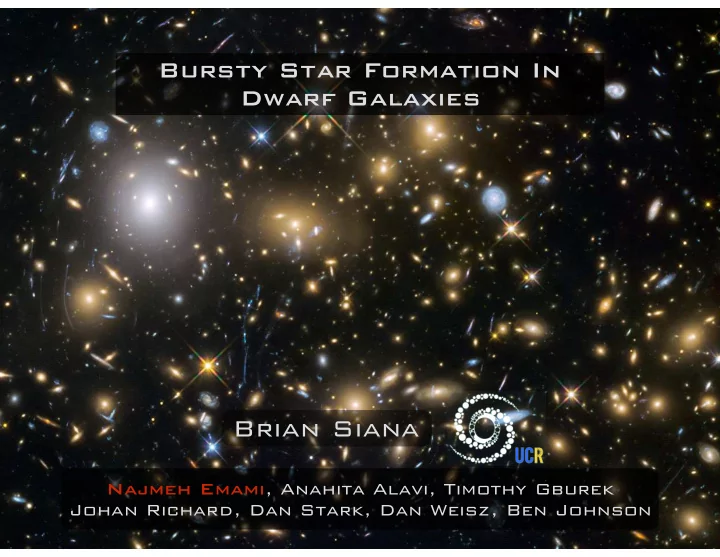

Bursty Star Formation In Dwarf Galaxies Brian Siana Najmeh Emami , Anahita Alavi, Timothy Gburek Johan Richard, Dan Stark, Dan Weisz, Ben Johnson
FIRE-2 SFHs (Hopkins et al. 2018) • Is this real? • Implications for feedback prescriptions. • If so, what are the implications for interpreting observables. Emami et al. (2018)
Characterizing Bursty Star Formation z=0 Emami et al. (2018) Lee et al. 2009, Meurer et al. 2009, McQuinn et al. 2010, Weisz et al. 2012, Iyer et al. 2019, Caplar et al. 2019
• Large scatter in SFR-M* locally in dwarf galaxies • Data from: • Lee et al. (2009) • Weisz et al. (2012) Emami et al. (2018)
L H α → ~3-5 Myr L UV → ~20-100 Myr Emami et al. (2018) Ask less of the data. Didn’t try to fit duty cycle (duration/period). • What is the timescale for star formation? •
Emami et al. (2018) Black: Data Blue: Model • Dwarf galaxies are bursty. • τ < 30 Myr @ M * < 10 8
Emami et al. (2018) Black: Data RED: FIRE-2 Simulations • Reasonable agreement with time scales and amplitudes of dwarf galaxies. • Primary difference is in the more massive galaxies: FIRE-2 galaxies seem to be changing on shorter timescales than observed.
Bursty Dwarf Galaxies at z~2
Alavi et al. (2014, 2016)
Keck Spectroscopic Follow-UP MOSDEF/KBSS Kriek+2015 Steidel+2016 Lensed n~1500 n~100 Fornax SMC LMC @ z~2!
Ionizing Photon Production Efficiency ξ ion = Ionizing Photon Rate = C L H α L UV L UV L UV C L H α Emami et al. (in prep.)
Ionizing Photon Production Efficiency • Question #1: What is the “typical” galaxy? log ( ξ ion ) • Median or average of • Question #2: What is the conversion from luminosity functions to ionizing photon production rate (per unit volume)? • Add up all ionizing photons divided by total UV luminosity density. Emami et al. (in prep.)
• ~0.2 dex more ionizing photons when considering bursty SF. • Small trend with stellar mass at z~2 • Evolution of 0.3 dex (factor of ~2) from z~2 to z~0 (iron deficiency in early universe) (a la Steidel et al. 2016). Emami et al. (in prep.)
z spec 2.59 Magnification 8 Gburek et al. (2019) log(M stel ) ~ 8.1 arxiv:1106.11849 M UV -18.7 12+log([O/H]) 8.06±0.12 (1/4 Z solar ) Gburek et al. (2019)
Mass-Metallicity Relation • A likely increased scatter in mass-metallicity relation at low mass. Gburek et al. (2019) Berg et al. (2018) FIRE: Ma et al. 2016
Conclusions • z~0 M * < 10 8 M ⊙ • Galaxies “bursty” at . • Timescale for SFR changes disagrees with FIRE-2 sims at high mass. • z~2 M * ∼ 10 8.5 M ⊙ • Galaxies “bursty” at least up to . ξ ion • No change with mass. ξ ion • Evolution of with redshift. • Fe/H evolution with z more important than O/H change with mass. • Likely a large scatter in O/H at low metallicity, possibly due to bursty SF.
Recommend
More recommend